|
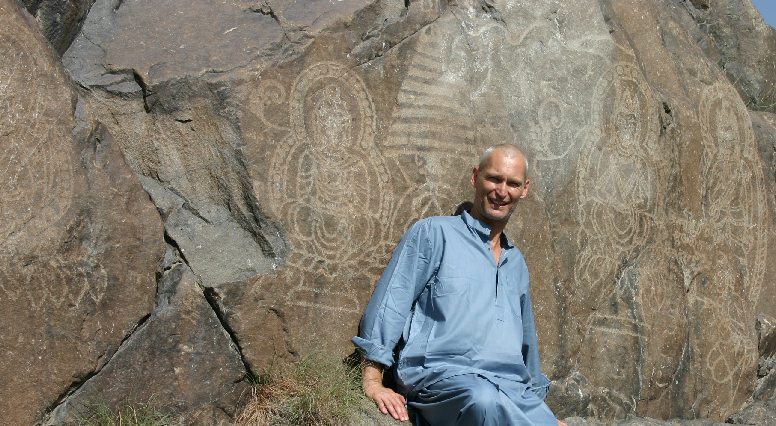 Pakistan is a great reservoir of the heritage
of the Indus, & Gandhara Civilizations.
With layers of various Gandhara Kingdoms, it is unsurpassed as a treasure
house of the Greco-Buddhist sculptures & artifacts. Moghul monuments are
strewn all over the country. Pakistan is a great reservoir of the heritage
of the Indus, & Gandhara Civilizations.
With layers of various Gandhara Kingdoms, it is unsurpassed as a treasure
house of the Greco-Buddhist sculptures & artifacts. Moghul monuments are
strewn all over the country.
Pakistanis truly take pride in their 5,000 years old history which goes
back even further into the hoary past yet untraced. In the words of Sir
Mortimer Wheeler, famed British Archaeologist, Pakistan enjoys a high
international position in the history of past achievements by virtue of
possessing the greatest vestiges of one of the first three mature
civilizations of the world. Pakistan is the known heir to one of the most
ancient civilizations of the east - the Indus Valley Civilization, traces of which
are found in the ruins of Moen-jo-Daro, Amri (on the right bank of the Indus
in Sind), Kot Diji (on the left) and way up in the plains of the Punjab (near
the city of Sahiwal), the remains of Harappa. The transition from rural past
to urban life in the Indus valley was so
suddent that outside influence looks very probable. It appears that merchants
of Mesopotamia who traded with settlements on the coast of the Persian Gulf
made deeper voyages and penetrated into the Indus
to find new trading partners, bringing with them their way of life. Indus
seals - both from Moen-jo-Daro and Harappa - show a remarkable similarity
with the finds at Tell Asmar, Ur and Kish in Sumer
and at Susa in south-western Iran. So do the pots and utensils
found in Mesopotamia and all along the Mekran coast and the cities on Indus. Later day evidence of organised civil life and
thriving cities in borne by the ruins of Taxila in the Haro valley, some 30
km west of Islamabad.
The famed Gandhara civilization flourished in the lush green valley of Peshawar nd the enchanting Swat. The
developments on Pakistan's
western frontiers made and un-made the history of South
Asia. The old Indus served as
the cradle of most civilization. The economy of the area still continues to
be closely linked with this giant river as it was during the Bronze Age when
Moen-jo_daro and other cities flourished on its banks, having trade and
commerce with contemporary civilizatio
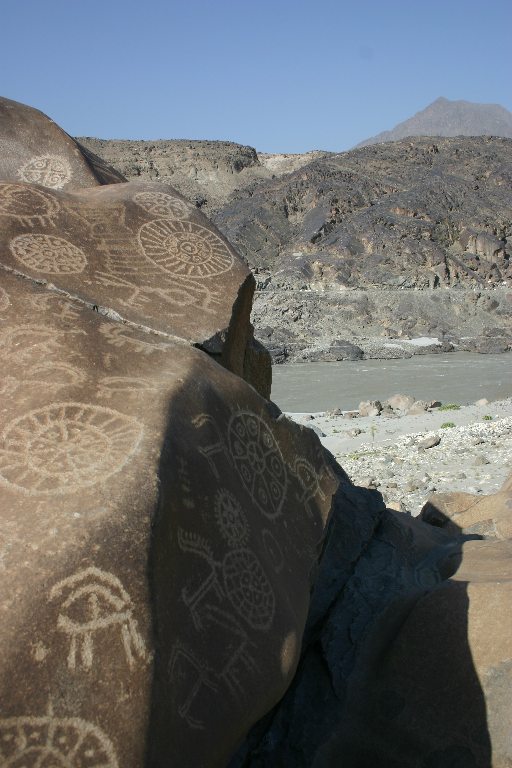 ns
in Iran and Mesopotamia. Most traces of the Indus Valley
civilization known abroad are the ruins of Moen-jo-Daro. To save them from
the rising sub-soil water UNESCO is cooperating with Pakistan which has resolved to
save the remians from total destruction at all costs. The 'brink towers' of
Moen-jo-Daro which impress and fascinate the visitors were, in fact, wells.
They are evidence of the fact that the well-planned city with its Great Bath
and Granary and 'palatial' houses and civic centers was build orginally 40
feet below the surface of the present ground level. It would be worthwhile mentioning
here some of the well-known finds from Moen-jo-daro which have over the years
become familiar. They are the figure of the dancing girl, the head of the
priest king and a large number of seals which bear animal figures, mostly
bulls, with pictographs. Reproductions of these steatite seals decorate many
a house in Pakistan
and world capitals. Wooden doors found during excavations show high order of
carpentry. These cities did not grow in a haphazard manner. they were build
taking into consideration not only security but also the hygiene and public
utilities. The planning and buildings were of a high order and showed
ingenuity. The unity of the long corridor of civilization is also testified
by a uniform system of weights and measures, traditions in arts and crafts,
social objectives and ideal, religious beliefs and rituals and a system of
pictographic writing and perhaps one language. The river seved as the main
means of communication-north to south and south to north. In the rugged
mountainous regions of western Pakistan the tribal traditions
exist even today. Their love of freedom in reflected in their folklore.
ns
in Iran and Mesopotamia. Most traces of the Indus Valley
civilization known abroad are the ruins of Moen-jo-Daro. To save them from
the rising sub-soil water UNESCO is cooperating with Pakistan which has resolved to
save the remians from total destruction at all costs. The 'brink towers' of
Moen-jo-Daro which impress and fascinate the visitors were, in fact, wells.
They are evidence of the fact that the well-planned city with its Great Bath
and Granary and 'palatial' houses and civic centers was build orginally 40
feet below the surface of the present ground level. It would be worthwhile mentioning
here some of the well-known finds from Moen-jo-daro which have over the years
become familiar. They are the figure of the dancing girl, the head of the
priest king and a large number of seals which bear animal figures, mostly
bulls, with pictographs. Reproductions of these steatite seals decorate many
a house in Pakistan
and world capitals. Wooden doors found during excavations show high order of
carpentry. These cities did not grow in a haphazard manner. they were build
taking into consideration not only security but also the hygiene and public
utilities. The planning and buildings were of a high order and showed
ingenuity. The unity of the long corridor of civilization is also testified
by a uniform system of weights and measures, traditions in arts and crafts,
social objectives and ideal, religious beliefs and rituals and a system of
pictographic writing and perhaps one language. The river seved as the main
means of communication-north to south and south to north. In the rugged
mountainous regions of western Pakistan the tribal traditions
exist even today. Their love of freedom in reflected in their folklore. 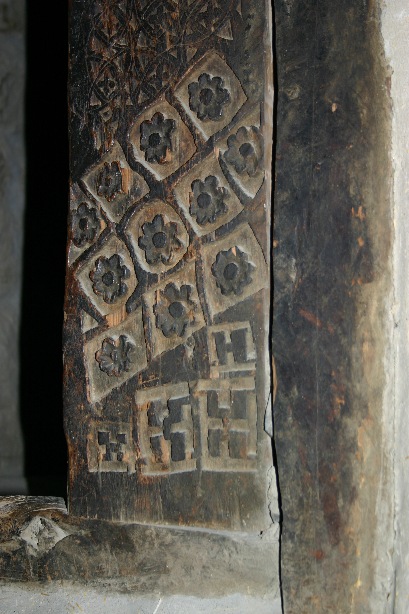 Nomads
as these people were, they moved eastward to the plains of Ganges
and got mingled with the caste-ridden culture of what they called
Bharatvarsha. Recorded history of the region begins in the middle of the
sixth century B.C. when the whole of the Indus region gradually became a part
of Iran's
Achaemenian empire under Cyrus, Darius and Xerxes. A notable feature of this
period was the consolidation of separate indentity of the Indus
zone from that of Bharatvarsha. A stream of ideas and social patterns also
followed via Iran from
Mesopotamia and the Levant. The Persian
rulers introduced their own weights and measures and the coin as a medium of
exchange. Kharoshti scripts took the place of pictography and new values gave
rise to such seats of learning as Taxila near which a fine example exists in
the hill-top monastery of Jaulian. Stone cutting and engraving were
introduced which led to the finest production of sculpture of that period -
specimens of which are sometimes found even today buried in the fields, in
and around the ruins. In-between the southern metropolis of Moen-jo-Daro and
the northern capital of the Indus Valley - Harappa -
are found traces of many flourishing cities dating back four to five thousand
years. One of these is Amri, also on the right bank of Indus,
some 160 km south of Moen-jo-Daro which French Archaeologist J.M. Casal put
as 4,000 years old. He also traced cities dating back to 2,500 B.C. in the
Kalat Division of Baluchistan - Nindowai and Ornach. But Kot Diji, 40 km east
of Moen-jo-Daro on the left bank, is one of the earliest known fortified
cities with a wall four to five meters high. It was a starting discovery in
the late fifties wh Nomads
as these people were, they moved eastward to the plains of Ganges
and got mingled with the caste-ridden culture of what they called
Bharatvarsha. Recorded history of the region begins in the middle of the
sixth century B.C. when the whole of the Indus region gradually became a part
of Iran's
Achaemenian empire under Cyrus, Darius and Xerxes. A notable feature of this
period was the consolidation of separate indentity of the Indus
zone from that of Bharatvarsha. A stream of ideas and social patterns also
followed via Iran from
Mesopotamia and the Levant. The Persian
rulers introduced their own weights and measures and the coin as a medium of
exchange. Kharoshti scripts took the place of pictography and new values gave
rise to such seats of learning as Taxila near which a fine example exists in
the hill-top monastery of Jaulian. Stone cutting and engraving were
introduced which led to the finest production of sculpture of that period -
specimens of which are sometimes found even today buried in the fields, in
and around the ruins. In-between the southern metropolis of Moen-jo-Daro and
the northern capital of the Indus Valley - Harappa -
are found traces of many flourishing cities dating back four to five thousand
years. One of these is Amri, also on the right bank of Indus,
some 160 km south of Moen-jo-Daro which French Archaeologist J.M. Casal put
as 4,000 years old. He also traced cities dating back to 2,500 B.C. in the
Kalat Division of Baluchistan - Nindowai and Ornach. But Kot Diji, 40 km east
of Moen-jo-Daro on the left bank, is one of the earliest known fortified
cities with a wall four to five meters high. It was a starting discovery in
the late fifties wh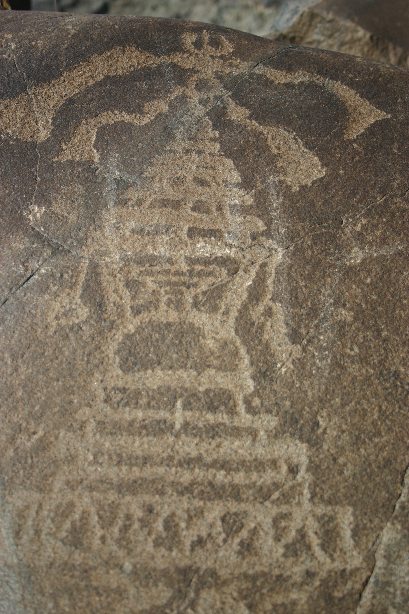 ich
gave ew evidence of pre-Harappan culture and pushed back Pakistan's history by another 500
years. The story of the discovery of Harappa,
which lay buried for many centuries, is interesting. In 1856 when the British
were building the Lahore to Multan
railway, they needed ballast and they found it in the form of finely baked
bricks of Harappa - millions of them. It was
only in 1872 that notice was taken of the mounds which stood 14 to 18 meters
above the level of the fields. It goes to the credit of Sir John Marshall
that the site was preserved in 1924-25. Excavation showed a city very similar
in planning to Moen-jo-Daro and it seemed to have almost everything for
comfortable living and a well-disciplined life. Objects found here are an
unending variety of pottery, jewellery, ornaments, human and animal
figurines, stone vessels, copper, bronze and silver utensils, metal objects,
beads, toold and implements and, of course, seals. Like Kot Diji, it too has
fortification wall with watch towers and bastions. Harappa's
layout showed a lofty fortified citadel and low lying city with public and
private buildings, workers colonies, work platforms and furnaces. The burial
system was same as found in Sumer
in 3 B.C. - bodies buried with ornaments and pottery in urn or otherwise.
Archaemenians' was a popular rule as people fought shoulder to shoulder with
the invaders from the west, including Alexander. Alexander's invasion (327
B.C.) left lasting impressions in the Indus
Valley and its traces are found
right from the north in Bajaur to south at Sehwan in Sind
where he built a fort. The Macedonian could not proceed further east beyond Beas. Though his rule was short-lived, the Indus valley absorbed many Hellenistic traditions.
Taxila is not just one site. It is said, over hundreds of years several
cities were built and destroyed in this small area among beautiful hills
which once full of forests. Among the well-preserved sites the oldest is Bhir
Mound near the famous Taxila
Museum which houses
some of the finest specimens of Ghandhara sculpture, gold ornaments and even
scientific instruments dug out from the ruins. Other sites include the
Dharmarajik Stupa, Sirkup - which was once a well-planned city on both sides
of a broad road with straight streets crossing it at right angles. Near it
are the ruins of the other city of Sirsukh
and monasteries and temples and the very interesting remains of the Buddhist
monastry stop a small hill which is in a well-preserved state, having small
stupas showing the social structure of the time. The structure of the
buildings is very different from that of ich
gave ew evidence of pre-Harappan culture and pushed back Pakistan's history by another 500
years. The story of the discovery of Harappa,
which lay buried for many centuries, is interesting. In 1856 when the British
were building the Lahore to Multan
railway, they needed ballast and they found it in the form of finely baked
bricks of Harappa - millions of them. It was
only in 1872 that notice was taken of the mounds which stood 14 to 18 meters
above the level of the fields. It goes to the credit of Sir John Marshall
that the site was preserved in 1924-25. Excavation showed a city very similar
in planning to Moen-jo-Daro and it seemed to have almost everything for
comfortable living and a well-disciplined life. Objects found here are an
unending variety of pottery, jewellery, ornaments, human and animal
figurines, stone vessels, copper, bronze and silver utensils, metal objects,
beads, toold and implements and, of course, seals. Like Kot Diji, it too has
fortification wall with watch towers and bastions. Harappa's
layout showed a lofty fortified citadel and low lying city with public and
private buildings, workers colonies, work platforms and furnaces. The burial
system was same as found in Sumer
in 3 B.C. - bodies buried with ornaments and pottery in urn or otherwise.
Archaemenians' was a popular rule as people fought shoulder to shoulder with
the invaders from the west, including Alexander. Alexander's invasion (327
B.C.) left lasting impressions in the Indus
Valley and its traces are found
right from the north in Bajaur to south at Sehwan in Sind
where he built a fort. The Macedonian could not proceed further east beyond Beas. Though his rule was short-lived, the Indus valley absorbed many Hellenistic traditions.
Taxila is not just one site. It is said, over hundreds of years several
cities were built and destroyed in this small area among beautiful hills
which once full of forests. Among the well-preserved sites the oldest is Bhir
Mound near the famous Taxila
Museum which houses
some of the finest specimens of Ghandhara sculpture, gold ornaments and even
scientific instruments dug out from the ruins. Other sites include the
Dharmarajik Stupa, Sirkup - which was once a well-planned city on both sides
of a broad road with straight streets crossing it at right angles. Near it
are the ruins of the other city of Sirsukh
and monasteries and temples and the very interesting remains of the Buddhist
monastry stop a small hill which is in a well-preserved state, having small
stupas showing the social structure of the time. The structure of the
buildings is very different from that of 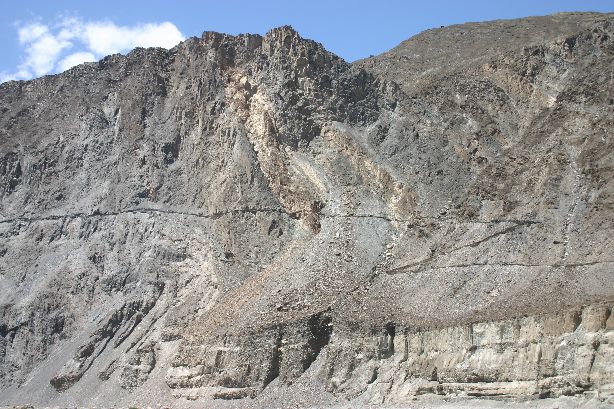 Moen-jo-Daro.
Instead of bricks, pebbles and bare rocks have been piles up to make walls
and fortifications. North of Peshawar is the valley of Swat
which is known for its beauty and remains of the Graeco-Roman origin. It was
called Udayan in the ancient times (now Udegram) and the nearby town of
Mingora, the capital of Swat, was called by Chinese traveller Hiueu Tsang as
Meng-Chie-Li. Near here as many as 2,000 pieces of sculptured slabs and
panels on the life of Buddha were discovered which included giled statues.
Some of the finds are housed in the Swat Museum.
The most important King of Kushans, Kanishka, controlled the main trade
routes from China and South Asia to the western world. His was one of the
most prosperous empire in the early history of this area. It led to the
flourishing of arts: the Ghandhara school of sculpture blossomed. Moen-jo-Daro.
Instead of bricks, pebbles and bare rocks have been piles up to make walls
and fortifications. North of Peshawar is the valley of Swat
which is known for its beauty and remains of the Graeco-Roman origin. It was
called Udayan in the ancient times (now Udegram) and the nearby town of
Mingora, the capital of Swat, was called by Chinese traveller Hiueu Tsang as
Meng-Chie-Li. Near here as many as 2,000 pieces of sculptured slabs and
panels on the life of Buddha were discovered which included giled statues.
Some of the finds are housed in the Swat Museum.
The most important King of Kushans, Kanishka, controlled the main trade
routes from China and South Asia to the western world. His was one of the
most prosperous empire in the early history of this area. It led to the
flourishing of arts: the Ghandhara school of sculpture blossomed.
Picture (left): SILK ROAD
through the Karakorum
mountains.
|

 ns
in
ns
in  Nomads
as these people were, they moved eastward to the plains of
Nomads
as these people were, they moved eastward to the plains of  ich
gave ew evidence of pre-Harappan culture and pushed back
ich
gave ew evidence of pre-Harappan culture and pushed back  Moen-jo-Daro.
Instead of bricks, pebbles and bare rocks have been piles up to make walls
and fortifications. North of Peshawar is the
Moen-jo-Daro.
Instead of bricks, pebbles and bare rocks have been piles up to make walls
and fortifications. North of Peshawar is the